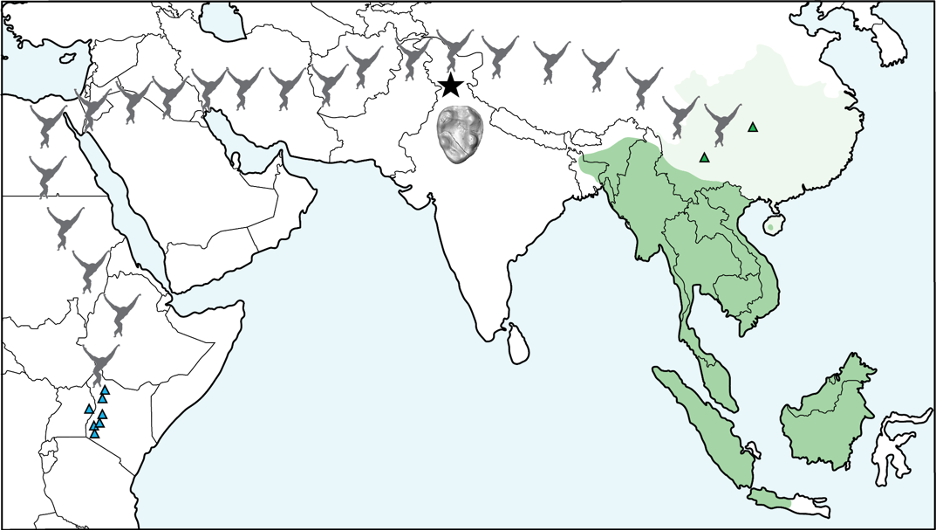New fossil ape is discovered in India

Field research site in Ramnagar, India. Image by Christopher Gilbert.
A 13-million-year-old fossil unearthed in northern India comes from a newly discovered ape, the earliest known ancestor of the modern-day gibbon. The discovery, published this week in the Proceedings of the Royal Society B, fills a major void in the ape fossil record and provides important new evidence about when the ancestors of today’s gibbon migrated to Asia from Africa.
The fossil, a complete lower molar, belongs to a previously unknown genus and species (Kapi ramnagarensis) and represents the first new fossil ape species discovered at the famous fossil site of Ramnagar, India, in nearly a century.
The fossil’s discovery was serendipitous. Research team members, including Research Associate Chris Campisano of Arizona State University's Institute of Human Origins, Christopher Gilbert, Biren Patel, Rajeev Patnaik and Premjit Singh, were climbing a small hill in an area where a fossil primate jaw had been found the year before. While pausing for a short rest, Gilbert spotted something shiny in a small pile of dirt on the ground, so he dug it out and quickly realized he’d found something special.
“We knew immediately it was a primate tooth, but it did not look like the tooth of any of the primates previously found in the area,” he said. “From the shape and size of the molar, our initial guess was that it might be from a gibbon ancestor, but that seemed too good to be true, given that the fossil record of lesser apes is virtually nonexistent. There are other primate species known during that time, and no gibbon fossils have previously been found anywhere near Ramnagar. So we knew we would have to do our homework to figure out exactly what this little fossil was.”
Since the fossil’s discovery in 2015, years of study, analysis and comparison were conducted to verify that the tooth belongs to a new species, as well as to accurately determine its place in the ape family tree. The molar was photographed and CT-scanned, and comparative samples of living and extinct ape teeth were examined to highlight important similarities and differences in dental anatomy.
“What we found was quite compelling and undeniably pointed to the close affinities of the 13-million-year-old tooth with gibbons,” said Alejandra Ortiz, a former Institute of Human Origins postdoctoral researcher now at New York University, who is part of the research team. “Even if, for now, we only have one tooth, and thus, we need to be cautious, this is a unique discovery. It pushes back the oldest known fossil record of gibbons by at least 5 million years, providing a much-needed glimpse into the early stages of their evolutionary history.”
In addition to determining that the new ape represents the earliest known fossil gibbon, the age of the fossil, around 13 million years old, is contemporaneous with well-known great ape fossils, providing evidence that the migration of great apes, including orangutan ancestors, and lesser apes from Africa to Asia happened around the same time and through the same places.

Map illustrating the location of Kapi (black star) relative to modern (dark green) and historical (light green) populations of lesser apes and the approximate distribution of early fossil apes in East Africa (blue triangles). Green triangles mark the location of previously discovered fossil gibbons. The new fossil is millions of years older than any previously known fossil gibbon and highlights their migration from Africa to Asia. Illustration by Luci Betti-Nash.
“I found the biogeographic component to be really interesting,” said Campisano, who is also an associate professor in ASU's School of Human Evolution and Social Change. “Today, gibbons and orangutans can both be found in Sumatra and Borneo in Southeast Asia, and the oldest fossil apes are from Africa. Knowing that gibbon and orangutan ancestors existed in the same spot together in northern India 13 million years ago, and may have a similar migration history across Asia, is pretty cool.”
The research team plans to continue research at Ramnagar, having recently received a grant from the National Science Foundation to continue their ongoing search for ape fossils.
Research article: “New Middle Miocene ape (primates: Hylobatidae) from Ramnagar, India, fills major gaps in the hominoid fossil record,” Proceedings of the Royal Society B. Chris Gilbert Anthropology, Hunter College, and the Graduate Center (both of the City University of New York); Alejandra Ortiz, New York University and the Institute of Human Origins, Arizona State University; Kelsey D. Pugh, American Museum of Natural History; Christopher J. Campisano, Institute of Human Origins and the School of Human Evolution and Social Change, Arizona State University; Biren A. Patel, Keck School of Medicine and the Department of Biological Sciences, University of Southern California; Ningthoujam Premjit Singh, Department of Geology, Panjab University; John G. Fleagle, Department of Anatomical Sciences, Stony Brook University; and Rajeev Patnaik, Department of Geology, Panjab University.
More Science and technology

The Dreamscape effect
Written by Bret HovellSeventh grader Samuel Granado is a well-spoken and bright student at Villa de Paz Elementary School in…

Research expenditures ranking underscores ASU’s dramatic growth in high-impact science
Arizona State University has surpassed $1 billion in annual research funding for the first time, placing the university among the…

Programming to predict the unpredictable
As the natural world rapidly changes, humanity relies on having reliable, accurate predictions of its behavior to minimize…